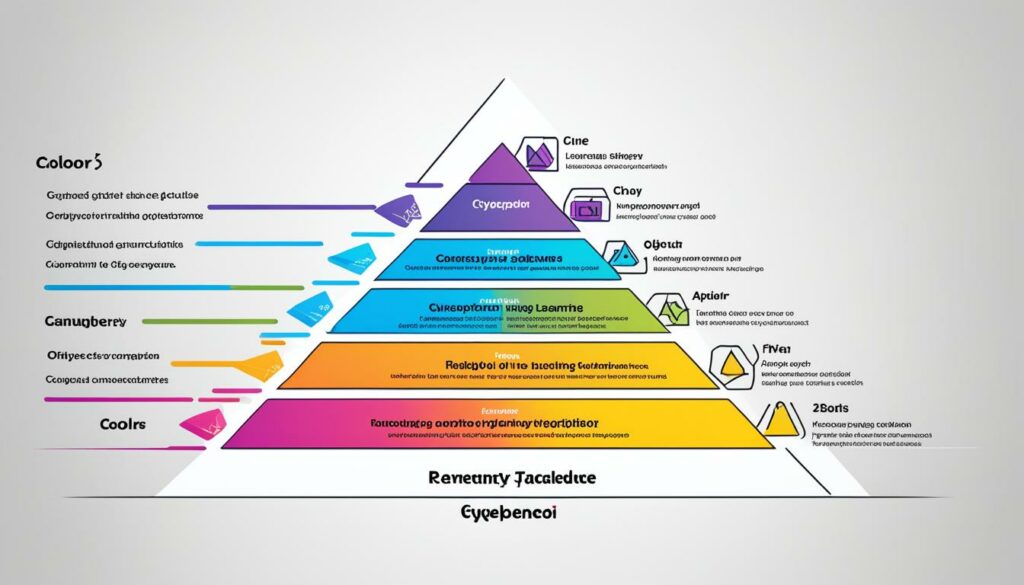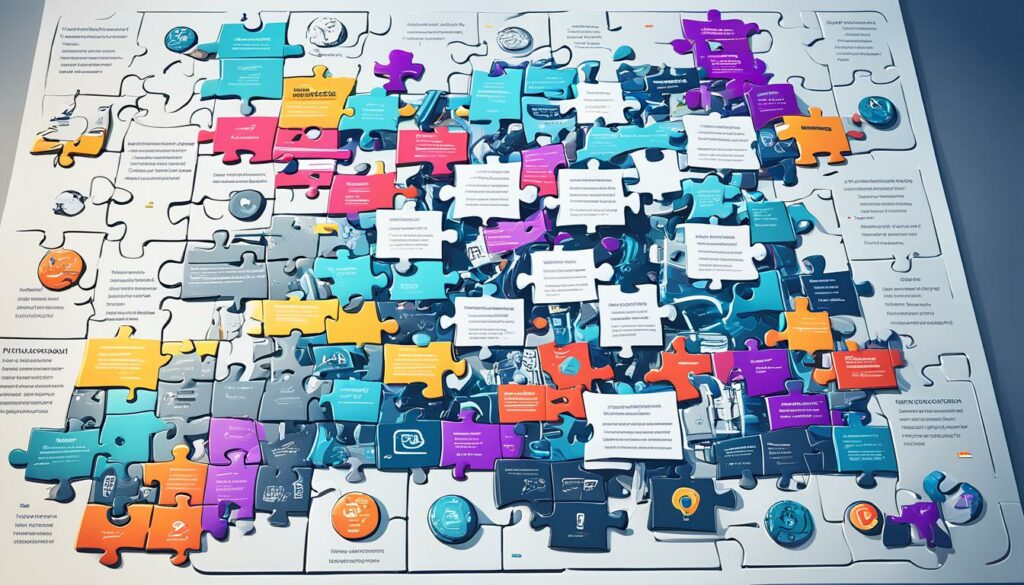When it comes to creating successful e-learning platforms, finding the right hosting solutions is crucial. Your hosting provider plays a vital role in ensuring a seamless and secure online education experience for your learners. Whether you are looking for e-learning website hosting or e-learning server hosting, it’s important to consider factors like reliability, scalability, and affordability.
In this article, we will explore the key insights and best practices for hosting solutions in e-learning platforms. From understanding the needs of your learners to selecting the right technology tools, we will guide you through each step of the process. By following these recommendations, you can create an e-learning platform that engages, educates, and empowers your audience.
Key Takeaways:
- Choosing the right hosting provider is essential for a seamless e-learning experience.
- Consider factors like reliability, scalability, and affordability when selecting your hosting solution.
- Understand the needs of your learners and define clear learning objectives.
- Create an instructional design plan that aligns with your objectives and addresses the challenges at hand.
- Select the appropriate technology tools, including hosting platforms, development/authoring tools, and Learning Management Systems (LMS).
Step 1: Conduct a Needs Analysis
The first step in creating successful e-learning content is to conduct a thorough needs analysis. This process involves understanding the specific e-learning problem or challenge you need to address and identifying the needs and expectations of your learners. By conducting stakeholder interviews, evaluating the current level of performance, and identifying gaps in knowledge or skills, you can gather crucial insights to inform your digital learning content development.
During stakeholder interviews, engage with key individuals who are invested in the success of your e-learning platform. This may include subject matter experts, instructors, learners, and administrators. By listening to their perspectives and understanding their goals, you can gain valuable information about their desired level of performance, as well as any challenges or areas for improvement they have identified.
“Conducting stakeholder interviews allows us to gain a deeper understanding of the e-learning problem we need to solve and the needs of our learners. It helps us align our digital learning content development with the expectations and goals of our stakeholders.”
In addition to stakeholder interviews, it’s essential to evaluate the current level of performance. This assessment helps you identify where your learners are currently at in terms of knowledge and skills. By comparing the current level of performance to the desired level of performance, you can determine the gaps that need to be addressed in your e-learning content.
Identifying these gaps is crucial for effective digital learning content development. It allows you to create targeted and relevant content that meets the needs of your learners, addresses the e-learning problem, and helps them bridge the knowledge or skills gap.
By conducting a thorough needs analysis and identifying the specific challenges, expectations, and gaps, you can lay a solid foundation for your e-learning content development. This step sets the stage for the subsequent stages of research, defining learning objectives, instructional design, and selecting appropriate technology tools. It ensures that your e-learning content is tailored to meet the unique needs of your learners and effectively addresses the e-learning problem or challenge at hand.
| Key Steps | Key Insights |
|---|---|
| Conduct stakeholder interviews | – Understand the e-learning problem – Identify learner needs and expectations |
| Evaluate current level of performance | – Determine where learners are – Identify knowledge or skills gaps |
| Identify gaps | – Address specific challenges – Tailor content to learner needs |
Step 2: Do Your Research
After conducting a needs analysis, it’s time to dive deep into the subject matter and gather valuable content resources for your e-learning course. Research plays a crucial role in developing engaging and informative content that resonates with your learners.
“Research is to see what everybody else has seen and to think what nobody else has thought.”
Start your research by setting broad parameters to understand the subject matter from different perspectives. Then, narrow down your focus to identify relevant resources that align with your learning objectives and cater to your target audience.
Here are a few key areas to consider when conducting your research:
Situational Resources
Explore real-life situations, case studies, or scenarios related to your subject matter. Analyze how they relate to the learning goals and provide practical insights and solutions.
Practical Resources
Look for resources that offer hands-on guidance and practical tips. These can include step-by-step tutorials, interactive exercises, or demonstrations that help learners apply their knowledge in real-world situations.
Facts Resources
Access reliable sources of factual information, such as research papers, textbooks, or scientific journals. These resources provide evidence-based knowledge and help you present accurate and up-to-date content.
Opinions Resources
Consider diverse viewpoints and opinions on the subject matter. These resources can include expert interviews, blog posts, or forum discussions that offer different perspectives, stimulating critical thinking and fostering open-mindedness.
To enhance your research, consider utilizing tools like Mendeley, Papers, and Google Scholar. These platforms can help you organize your findings, track citations, and discover additional relevant resources.

Remember, thorough research is fundamental to crafting high-quality e-learning content. By gathering a variety of resources, you can provide learners with valuable insights, practical skills, and a well-rounded learning experience.
Step 3: Define Learning Objectives
In order to create successful e-learning content, it is essential to define clear and SMART learning objectives. These objectives provide a roadmap for your e-learning materials and help guide your learners towards specific outcomes. SMART goals are those that are Specific, Measurable, Achievable, Relevant, and Time-bound. By setting SMART objectives, you can ensure that your e-learning content is focused, effective, and impactful.
Specific objectives outline precisely what the learner should be able to achieve after completing the e-learning module. They should be clear, concise, and leave no room for ambiguity. For example, a specific objective could be “By the end of this module, the learner will be able to code a basic HTML webpage from scratch.”
Measurable objectives allow you to track and evaluate the learner’s progress. They provide a quantifiable criteria for determining if the objective has been met. For example, a measurable objective could be “The learner will achieve a score of 80% or higher on the end-of-module quiz.”
Achievable objectives are realistic and attainable within the given timeframe and resources. They take into consideration the learner’s current knowledge and abilities. For example, an achievable objective could be “The learner will be able to complete the coding exercise with the provided resources and support.”
Relevant objectives align with the overall goals of the e-learning program and are directly applicable to the learner’s needs and objectives. They address the specific skills or knowledge gaps that the e-learning module aims to fill. For example, a relevant objective could be “The learner will gain practical skills in web design to enhance their employability.”
Time-bound objectives have a specific deadline or timeframe for completion. They help create a sense of urgency and ensure that the learner stays on track. For example, a time-bound objective could be “The learner will complete the module within two weeks from the start date.”
By defining learning objectives that are SMART, you set clear expectations for both yourself as the content creator and your learners. These objectives serve as a foundation for designing relevant and effective e-learning content. When learners have a clear understanding of what they will achieve by the end of the module, their motivation and engagement levels increase, leading to a more successful learning experience.
“Learning objectives provide a roadmap for your e-learning materials and help guide your learners towards specific outcomes.”
Useful resources for defining learning objectives:
- University of California SMART Goals How-To Guide
- A New Taxonomy of Educational Objectives

Step 4: Build Your Instructional Design Plan
Now that you have clearly defined your learning objectives, it’s time to build an instructional design plan that not only aligns with those objectives but also addresses the problem or challenge at hand. An effective instructional design plan will lay the foundation for a successful e-learning experience, engaging learners and facilitating their knowledge acquisition.
One popular model that can guide your instructional design is Marzano’s Taxonomy. Developed by educational expert Robert J. Marzano, this taxonomy provides a framework for organizing instructional goals and objectives into distinct levels of cognitive complexity. By incorporating Marzano’s Taxonomy into your design plan, you can ensure that your e-learning content covers a wide range of cognitive skills, from basic recall to critical thinking and problem-solving.
Furthermore, it’s important to draw on research-based theories like socio-cultural learning and situated cognition when designing your instructional plan. Socio-cultural learning theory emphasizes the importance of social interaction and cultural context in learning, suggesting that learners construct knowledge through collaborative activities, discussions, and real-world experiences. Similarly, situated cognition theory posits that learning is most effective when it occurs in authentic and meaningful contexts.
Remember, the goal of your instructional design plan is to create a learning experience that not only imparts knowledge but also engages learners and encourages active participation. By leveraging the principles of socio-cultural learning and situated cognition, you can design activities and assessments that promote collaboration, critical thinking, and real-world application of knowledge.
To ensure a systematic approach to instructional design, consider adopting established frameworks like ADDIE (Analysis, Design, Development, Implementation, Evaluation) and Bloom’s Taxonomy. ADDIE provides a structured methodology for the development of effective instructional materials, ensuring that all aspects of the design process are thoroughly considered and evaluated. On the other hand, Bloom’s Taxonomy offers a hierarchical classification of learning objectives, helping you design activities and assessments that align with specific cognitive processes and levels of complexity.
By combining key elements from Marzano’s Taxonomy, socio-cultural learning theory, situated cognition theory, ADDIE, and Bloom’s Taxonomy, you can create a comprehensive and effective instructional design plan that maximizes learning outcomes for your e-learning platform.

| Key Elements | Benefits |
|---|---|
| Marzano’s Taxonomy | – Ensures coverage of cognitive skills – Facilitates critical thinking and problem-solving |
| Socio-cultural learning theory | – Promotes collaboration and social interaction – Supports knowledge construction through meaningful context |
| Situated cognition theory | – Enhances real-world application of knowledge – Increases engagement and relevance |
| ADDIE framework | – Provides a systematic approach to instructional design – Ensures thorough consideration of all design aspects |
| Bloom’s Taxonomy | – Guides the design of activities and assessments based on cognitive processes and complexity levels – Supports the achievement of specific learning objectives |
By incorporating these elements into your instructional design plan, you can create an engaging and effective e-learning experience that meets the needs of your learners and addresses the challenges and problems you aim to overcome.
Step 5: Identify the Technology You’ll Use
After designing your instructional plan, it’s time to explore and select the technology tools and solutions that will support your e-learning platform. Choosing the right technology is crucial to ensure that your platform is accessible, user-friendly, and engaging. Here are some key elements to consider:
Hosting Solutions
When it comes to hosting your e-learning platform, reliability and security are paramount. Look for hosting providers that offer secure, scalable, and reliable hosting solutions specifically tailored for e-learning platforms. Some popular hosting providers include Bluehost, SiteGround, and HostGator.
Development/Authoring Tools
To create engaging and interactive e-learning content, you’ll need reliable development and authoring tools. Here are some popular options:
- Articulate Storyline 360: A powerful authoring tool that allows you to create interactive and customizable courses.
- Articulate Rise: An intuitive tool for creating responsive and mobile-friendly courses without any coding.
- Adobe Captivate: A comprehensive e-learning authoring tool with advanced features for creating multimedia-rich courses.
Learning Management Systems (LMS)
An LMS is a crucial component of any e-learning platform as it manages the delivery, tracking, and assessment of online courses. Here are some popular LMS options:
- 360Learning LMS: A collaborative LMS that enables interactive and social learning experiences.
- ShareKnowledge: A feature-rich LMS that integrates seamlessly with Microsoft SharePoint for easy content management.
Delivery Options
Consider the different delivery options available for your e-learning platform. These options include web-based courses, mobile apps, or even offline access. Ensure that the technology you choose supports the delivery methods that align with your learners’ needs and preferences.
Video Creation and Hosting Tools
Videos are a highly effective way to deliver engaging e-learning content. Here are some popular video creation and hosting tools:
- Vimeo: A versatile video hosting platform that offers customization options and secure video delivery.
- Magisto: A user-friendly video creation tool that uses artificial intelligence to automate the editing process.
By carefully selecting the technology tools and solutions that align with your e-learning objectives and vision, you can create an impactful and successful e-learning platform that meets the needs of your learners.
Conclusion
Creating successful e-learning platforms requires careful planning, research, and technology selection. By following the key insights and best practices outlined in this article, you can ensure that your hosting solutions for e-learning platforms are secure, reliable, and scalable.
Conducting a needs analysis is the first step in creating effective e-learning content. By understanding the needs of your learners and stakeholders, you can design courses that address their specific challenges and goals.
Thorough research is essential to gather relevant content and resources for your e-learning platform. By leveraging tools like Mendeley, Papers, and Google Scholar, you can explore a wide range of situational, practical, factual, and opinion resources to enhance your courses.
Defining clear and SMART learning objectives is crucial to ensure that your e-learning content is focused and effective. By aligning your objectives with desired outcomes, you can provide a meaningful learning experience for your audience.
Building an instructional design plan that incorporates research-based theories and established frameworks further enhances the effectiveness of your e-learning platform. Consider utilizing models like Marzano’s Taxonomy and theories such as socio-cultural learning and situated cognition to create engaging and impactful courses.
Choosing the right technology tools and solutions is essential for a seamless e-learning experience. Optimize your platform with reliable hosting solutions, development/authoring tools like Articulate Storyline 360 and Adobe Captivate, and efficient Learning Management Systems (LMS) such as 360Learning LMS and ShareKnowledge.
By following these best practices and implementing the right approach, your e-learning platform can provide engaging and informative content to learners, leading to successful online education experiences.
FAQ
Q: What is a needs analysis?
A: A needs analysis is the process of identifying the learners, their learning objectives, and the problem or challenge your e-learning platform aims to address. It involves conducting stakeholder interviews, evaluating current performance levels, and identifying gaps.
Q: How can I conduct effective research for my e-learning platform?
A: To conduct effective research, deep-dive into the subject matter and gather relevant content and resources for your course. Start with broad parameters and narrow down your research to identify Situational, Practical, Facts, and Opinions resources. Useful tools for research include Mendeley, Papers, and Google Scholar.
Q: How do I define learning objectives for my e-learning platform?
A: Define clear and SMART (Specific, Measurable, Achievable, Relevant, Time-bound) learning objectives that align with the desired learning outcomes. You can use resources like the University of California SMART Goals How-To Guide and A New Taxonomy of Educational Objectives to help you with this process.
Q: What is an instructional design plan?
A: An instructional design plan is a framework that aligns with your learning objectives and addresses the problem or challenge your e-learning platform aims to solve. Popular models include Marzano’s Taxonomy, which incorporates research-based theories like socio-cultural learning and situated cognition, as well as established frameworks like ADDIE and Bloom’s Taxonomy.
Q: How do I select the right technology for my e-learning platform?
A: Selecting the right technology involves choosing a hosting solution, development/authoring tools, a Learning Management System (LMS), and delivery options. Popular e-learning development tools include Articulate Storyline 360, Articulate Rise, Adobe Captivate, and LMS options like 360Learning and ShareKnowledge. Video creation and hosting tools like Vimeo and Magisto can also enhance your e-learning platform’s engagement.
Q: What are the key insights and best practices for hosting solutions for e-learning platforms?
A: Creating successful e-learning platforms requires conducting a needs analysis, doing thorough research, defining clear learning objectives, building an instructional design plan, and selecting the right technology tools. By following these steps and best practices, you can ensure that your e-learning platform’s hosting solutions are secure, reliable, and scalable, providing engaging and informative content to learners.












